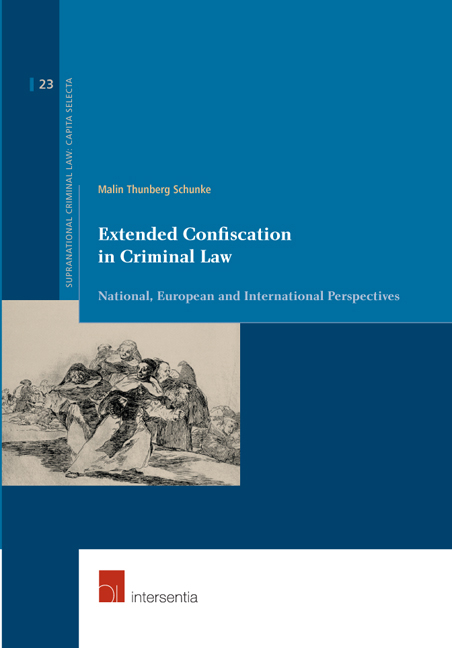Book contents
- Frontmatter
- Preface
- Contents
- Table of Cases
- List of Abbreviations
- Part I Introduction
- Part II Substantive Provisions on Extended Confiscation
- Chapter 2 Legislative Action by the EU
- Chapter 3 Legislation in England and Wales
- Chapter 4 Legislation in Germany
- Chapter 5 Legislation in Sweden
- Chapter 6 Brief Overview of the Legislation in Norway, Denmark and Finland
- Chapter 7 Directive 2014/42/EU: A Reform with Significant Legal Changes?
- Part III The Legal Framework for International Cooperation
- Bibliography
- Index
- About the Author
Chapter 5 - Legislation in Sweden
from Part II - Substantive Provisions on Extended Confiscation
Published online by Cambridge University Press: 11 October 2018
- Frontmatter
- Preface
- Contents
- Table of Cases
- List of Abbreviations
- Part I Introduction
- Part II Substantive Provisions on Extended Confiscation
- Chapter 2 Legislative Action by the EU
- Chapter 3 Legislation in England and Wales
- Chapter 4 Legislation in Germany
- Chapter 5 Legislation in Sweden
- Chapter 6 Brief Overview of the Legislation in Norway, Denmark and Finland
- Chapter 7 Directive 2014/42/EU: A Reform with Significant Legal Changes?
- Part III The Legal Framework for International Cooperation
- Bibliography
- Index
- About the Author
Summary
THE DEVELOPMENT OF THE MEASURE OF EXTENDED CONFISCATION IN SWEDISH LAW
The regime on confiscation has been continually amended and extended in Swedish law. Space does not allow an exhaustive description of this general development, but in what follows a short outline of the reasons for the introduction of the measure of extended confiscation will be given. Of significant importance for the development of the Swedish system of confiscation as a whole was the Ministry of Justice Report on more efficient legislation on confiscation, which was published in 1999. The motive for setting up this inquiry was to elaborate proposals for improved rules in order to counteract large-scale organised and financial crime. The report concluded in general that the measure of confiscation had had limited use in Swedish practice, and that the legal provisions were unclear and ineffective. The significant evidentiary difficulties in showing a link between the crime in question and the property to be confiscated were especially highlighted. Several proposals were made in order to strengthen the measure of confiscation and overcome the investigatory shortcomings. Among these was also a proposal for a form of extended confiscation, which had largely been inspired by the Norwegian legislation. The report resulted in several changes in national legislation regarding ordinary confiscation, but the measure of extended confiscation was not finalised at this legislative stage.
Instead, the development towards the introduction of such a measure was triggered by a number of international undertakings. Of most importance became the adoption in 2005 of FD 2005/212/JHA. The main part of this instrument was implemented in Swedish law through legal provisions that came into force in 2005. However, the adoption of provisions on extended confiscation, in accordance with Article 3 of the instrument, was left pending on this occasion because the matter was deemed to require more thorough investigation.
- Type
- Chapter
- Information
- Extended Confiscation in Criminal LawNational, European and International Perspectives, pp. 129 - 178Publisher: IntersentiaPrint publication year: 2017



